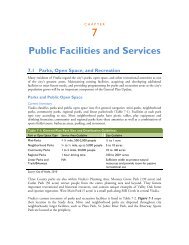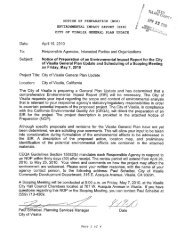General Plan Update Review Committee Draft Elements Part 2 For ...
General Plan Update Review Committee Draft Elements Part 2 For ...
General Plan Update Review Committee Draft Elements Part 2 For ...
You also want an ePaper? Increase the reach of your titles
YUMPU automatically turns print PDFs into web optimized ePapers that Google loves.
Objectives<br />
S-O-1 Minimize risks of property damage and personal<br />
injury posed by geologic and seismic<br />
hazards.<br />
Policies<br />
S-P-1 *Work with Caltrans to seismically retrofit<br />
or replace local ramps and freeway overpass<br />
bridges that are categorized as structurally<br />
deficient by Caltrans, are located in<br />
high ground shaking areas, and/or are necessary<br />
for first responders to use during and/<br />
or immediately after a disaster or emergency.<br />
S-P-2 *Seismically retrofit or replace public works<br />
and/or emergency response facilities that are<br />
necessary during and/or immediately after a<br />
disaster or emergency.<br />
S-P-3 *<strong>Update</strong> the City’s Emergency Preparedness<br />
<strong>Plan</strong> to include an Earthquake Disaster <strong>Plan</strong>,<br />
and coordinate procedures with the County<br />
Emergency Services.<br />
S-P-4 *Establish a public relations and education<br />
program to increase community awareness<br />
for emergency preparedness, including “community<br />
emergency preparedness teams.”<br />
Involving residents and having voluntary programs<br />
to help people prepare is the key to an<br />
effective program.<br />
S-P-5 *<strong>Update</strong> subdivision and zoning ordinance<br />
review criteria to include seismic considerations.<br />
S-P-6 *Continue to inspect unoccupied existing<br />
unreinforced masonry structures and “critical<br />
facilities” constructed prior to 1948 and<br />
develop condemnation procedures to be<br />
included in a dangerous building ordinance.<br />
S-P-7 *Consult with a qualified engineering geologist<br />
to periodically review the Safety Element.<br />
8.2 FLOOD HAZARDS<br />
Visalia is subject to flood hazards, but not inundation<br />
hazards related to dam failure. Since the climate<br />
is relatively arid and development continues<br />
to increase the amount of impervious surfaces, surface<br />
run-off and storm drainage must be managed.<br />
The average annual precipitation in the Visalia area<br />
is approximately 11 inches. However, portions of the<br />
Kaweah watershed which contributes to flooding<br />
in Visalia have a mean annual precipitation of 40<br />
inches. Eighty–five percent of the annual precipitation<br />
occurs between November and April.<br />
In the <strong>Plan</strong>ning Area, waterways and surface runoff<br />
generally flow from east to west, terminating in the<br />
Tulare Lake Basin. Channels include the St. John’s<br />
River, Modoc Ditch, Mill Creek Ditch, Mill Creek,<br />
Tulare Irrigation District (TID) Canal, Packwood<br />
Creek, Cameron Creek, Deep Creek, Evans Creek,<br />
Persian Ditch (See Figure 8-2). Most watercourses<br />
are intermittent drainages that receive a significant<br />
portion of flow from storm water runoff during the<br />
rainy season. This intermittent flow is typically supplemented<br />
from water released from Terminus Dam<br />
on the Kaweah River.<br />
DRAFT ELEMENTS<br />
<strong>For</strong> <strong>General</strong> <strong>Plan</strong> <strong>Update</strong> <strong>Review</strong> <strong>Committee</strong><br />
AUGUST 2012<br />
8-5




